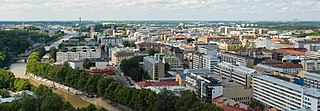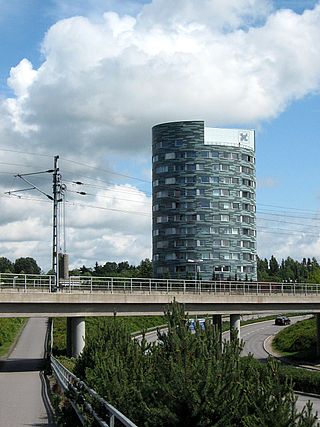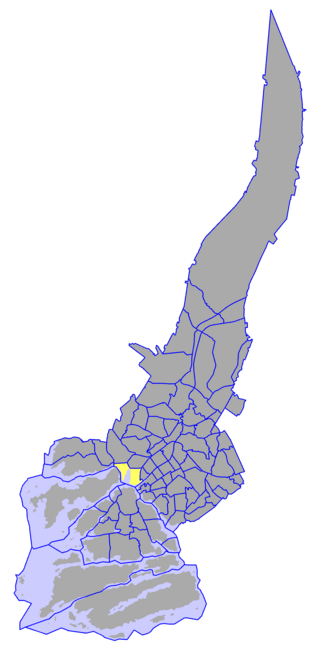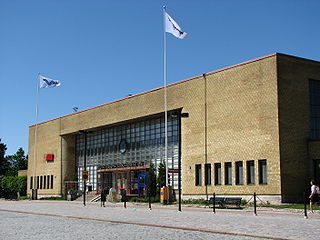
Turku is a city and former capital on the southwestern coast of Finland at the mouth of the River Aura, in the region of Southwest Finland (Varsinais-Suomi) and the former Turku and Pori Province. The region was originally called Suomi (Finland), which later became the name of the whole country. The population of Turku is 201,085 making it the sixth largest city in Finland. The Turku region has a population of 345,522, making it the third largest urban area in Finland after the Helsinki and Tampere regions. The city is officially bilingual, with 5.5 per cent of the population having Swedish as their mother tongue.

The Royal Academy of Turku or the Royal Academy of Åbo was the first university in Finland, and the only Finnish university that was founded when the country still was a part of Sweden. It was founded in 1640. In 1809, after Finland became a Grand Duchy under the suzerainty of the Russian czar, it was renamed the Imperial Academy of Turku. In 1828, after the Great Fire of Turku, the institution was moved to Helsinki, in line with the relocation of the Grand Duchy's capital. It was finally renamed the University of Helsinki when Finland became a sovereign nation-state in 1917.

Nousiainen is a municipality of Finland. It is located in the Southwest Finland region, 20 kilometres (12 mi) from Turku along Highway 8 (E8). The Finnish-speaking municipality has a population of 4,695 (30 September 2023) and covers an area of 199.55 square kilometres (77.05 sq mi) of which 0.62 km2 (0.24 sq mi) is water. The population density is 23.6 inhabitants per square kilometre (61/sq mi).

Turku Student Village is the largest single student housing complex in Finland. It houses nearly 3,500 residents in 95 three-storied tenements. The Student Village is located in the district of Nummi near the city centre of Turku. It is in the immediate proximity of the University of Turku, Åbo Akademi University and the Turku School of Economics and Business Administration.

The Port of Turku is a port located in the south-west of Finland, where the mainland meets the beginning of the Turku archipelago. Sited within Finland's sixth largest city, the port principally handles traffic between Turku and the Swedish capital of Stockholm and the enclaved Åland.
The city of Turku, Finland is divided into nine wards, which in turn are divided into 78 non-governmental districts. These are composed of individual suburbs, and in the very centre of the city, sectors of the central business district are identified by Roman numerals. This is a list of the districts in Turku in alphabetical order, grouped by wards.

Turku Central Station is a railway station in the VII District of Turku, Finland. It has VR services to Helsinki and towards Joensuu. The station serves approximately a million passengers annually.
Turun sinappi is a mustard made in Finland. It is often served with makkara.

City Centre is a ward of Turku, Finland, also known as Ward 1. The ward's boundaries correspond approximately to those of the city's central business district, and it borders all the other wards of Turku except for Maaria-Paattinen.
The Archdiocese of Turku, historically known as Archdiocese of Åbo, is the seat of the Archbishop of Turku. It is a part of the Evangelical Lutheran Church of Finland, and its see city is Turku.

The Great Fire of Turku was a conflagration in the city of Turku in 1827. It is still the largest urban fire in the history of Finland and the Nordic countries. The city had burned once before, in 1681.

Kupittaa railway station is located in the Kupittaa district of Turku, Finland. The station is located about three kilometres from the Turku Central railway station in the immediate vicinity of the Turku Science Park. All trains between Helsinki and Turku stop at Kupittaa. The station is part of the Turku traffic point, and traffic control is handled from Turku Central railway station. The station has bus connections to Turku internal lines 32, 42 and 58 and regional line 110.

Vartiovuori Observatory is a former observatory in Turku, Finland. The observatory, designed by Carl Ludvig Engel, was originally built for the Royal Academy of Turku. The neoclassical building was completed in 1819. The observatory is situated atop the Vartiovuori hill, and it is clearly visible from different sides of the city centre.

The Turku Region, The City Region of Turku and Greater Turku all refer to regions of different size surrounding Turku, the capital city of the region of Southwest Finland. The Turku Region is one of the Sub-regions of Finland. The Turku Region has a population of 366,180, making it the third largest region in Finland after Helsinki and Tampere.

Turku City Library is a municipal public library in Turku. The Main Library is located in the VI District at the city centre. The Turku City Library also operates several branch libraries and two mobile libraries. It is part of the Vaski library network, which is a consolidation of 18 public libraries in the Southwest Finland region.

Åbo IFK is a sports club from Turku, Finland. The club was founded in 1908, and originally represented the Swedish-speaking minority of Turku/Åbo.

The Sibelius Museum is a museum of music, named after the Finnish composer Jean Sibelius. The museum is located close to Turku Cathedral in the historical city centre of Turku on the southwest coast of Finland. It is the only museum devoted to music in Finland. The museum houses a wide collection of historical music instruments from around the world. The archives of the museum include documents The museum was first founded during the 1920s as a seminar for the Department of Musicology at Åbo Akademi University, and has later developed into its own department. The Museum is currently organised and funded by the Åbo Akademi Foundation. The current building was built and opened in 1968 and it was designed by architect Woldemar Baeckman.

Turku Repair Yard Ltd is a Finnish ship repair company. Its premises are situated in Luonnonmaa island, Naantali. The company has focused on repairing of ships and boats.
The Tomten in Åbo Castle is a Finnish fairy tale from 1849 by Zachris Topelius. It tells the story of a friendship between an old tomten, who lived in Turku Castle for hundreds of years, and his only human friend. At the time of writing, the medieval Turku Castle, the site of events, was badly damaged, and the story had a major influence on the desire to restore this important landmark in the City of Turku.
Carl Axel Johan Gadolin was a Finnish doctor of philosophy and a writer in Swedish. He also used the pseudonyms Alexander Gaditz and Kristian Ulfsby.














